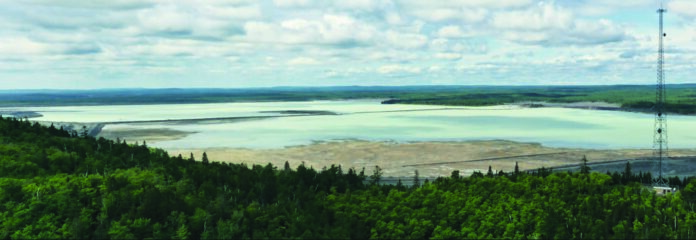Last month, the Northshore Journal published an article that covered some of the controversial history surrounding Reserve Mining’s practice of discharging mining waste directly into Lake Superior at Silver Bay. That practice continued from 1956, when iron ore processing began in Silver Bay, until 1980, when Reserve Mining was forced by court order to develop a way to deposit waste material on land. The purpose of the article was to give an accurate account of the impacts that Reserve Mining’s practice had on Lake Superior and the communities surrounding Silver Bay and as far south as Duluth. The legal battles that ensued over those practices resulted in the construction of the Mile Post 7 tailings dam. Recent plans to expand the tailings dam have understandably reignited concern over the possible effects that expansion may pose to the environment and the people who live in proximity to Mile Post 7.
Both Cleveland Cliffs and Northshore Mining were contacted in the hope that company officials would respond to some of the concerns and questions that people have about the plan to expand Mile Post 7. That plan apparently relies on an environmental review that is 40 years old and is itself somewhat controversial. As of this writing, no official from Cleveland Cliffs or Northshore Mining has responded to requests for information. In the absence of a response from corporate officials, I have turned to the Department of Natural Resources (DNR) and the Minnesota Pollution Control Agency (MCPA), seeking answers to questions about monitoring and the safety of the site. In next week’s issue of the Northshore Journal, the thoughts, opinions and concerns of area residents who are most likely to be impacted by the Mile Post 7 expansion will be presented.
The following questions were posed to the DNR Office of Communications and Outreach. Their answers here are rendered verbatim.
What is the current volume of tailings debris stored at Mile Post 7 and what is the projected volume that expansion will allow?
“The volume of existing tailings stored at Mile Post 7 is 119,118,000 long tons of material”. The DNR asserts that the “proposed project at Mile Post 7 is not an expansion of the tailings basin, as the proposed dam extension will not increase the available tailings storage of the facility. Rather, using the remaining capacity of the tailings basin requires construction of the dams based on an ongoing assessment of conditions at the facility”. This will allow for the storage of an estimated 753,023,000 long tons of tailings”.
One may find the above wording confusing. Presumably, “not increasing the available tailings storage at the facility refers to the surface area that currently comprises the Mile Post 7 site. That surface area will apparently not be expanded. It seems that dam extensions, however, (raising the dam height from 1,240 feet to 1,365 feet) will increase the volume of tailings debris stored at Mile Post 7.
How long will the Mile Post 7 site be actively used to collect tailings waste?
“The length of time during which additional tailings may be added to the Mile Post 7 tailings basin is a function of the overall length of a Permit to Mine. The permit term for this facility will be established during the required process to amend the current Permit to Mine. The Permit to Mine currently estimates that operations, reclamation, and closure will be complete by 2078. This estimate includes approximately 10 years for reclamation beyond active mining, processing, and waste disposal”.
Mile Post 7 is a toxic waste site. Is that toxicity permanent or does it diminish over time?
“Mile Post 7 is a tailings disposal facility and is not considered a toxic waste site under state or federal law. Tailings are roughly composed of sand-to-talc sized particles of left-over ground rock from the processing of mined ore. The Mile Post 7 basin is required to comply with all state and federal laws, as well as permit conditions regulating management of mineral fibers, water quality, air quality, operations, reclamation, and closure. Any discharges or emissions from the tailings basin must meet all laws and permit requirements during the active life of the facility and in closure”.
Can you explain some of the design, monitoring and safety measures that reduce the risk of possible dam failure?
(The) “Mile Post 7 tailings dams are some of the most closely regulated dams in the state, meeting all applicable factors of safety and state dam safety laws.
Tailings dams are designed with careful consideration of all potential failure modes, including slope failure or overtopping. Engineers investigate the underlying area and dam construction materials through geotechnical investigations to determine the material strengths. Those material strengths are entered into computer stability models, along with conservative assumptions for conditions such as a very high pond level, to test the stability of the proposed dam. Factors of Safety for various conditions (i.e., liquefaction, seismic activity, weather events, etc.) under current and future conditions are determined and compared against industry standards. If a dam does not meet or exceed these requirements, the project proposer’s engineer of record would need to identify what measures should be applied to increase stability and bring the facility to the appropriate Factors of Safety. If (the) DNR were to determine that the design of a dam was unsafe (i.e., did not meet the Factors of Safety), the design would not be approved, and the dam could not be constructed.
The Mile Post 7 dams are monitored in a variety of ways. Water levels in the tailings basin are monitored to ensure there is adequate storage for an extreme flood. Instrumentation in the ground, such as piezometers, measures groundwater conditions in, under, and around the dams. Inclinometers and settlement plates measure movement and settlement of the dam embankments. On-site staff conduct routine inspections, the engineer of record conducts multi-day annual inspections, and DNR dam safety engineers conduct annual inspections of the dams. These inspections include a review of these records and a visual inspection to determine if there is any condition that could lead to dam failure. Any findings are documented and required to be addressed.
The Mile Post 7 dams include a number of design and operational components to help ensure the safety of the dam. The pond level is maintained at a low enough level to provide capacity to safely store the water associated with an extreme flood event. An emergency action plan includes a dam breach analysis to understand the impacts of a hypothetical breach of the dam. The emergency action plan also identifies specific steps to be taken in the unlikely event of a breach of the dam, such as notifications to the public and procedures for evacuation and road closures. The plan identifies the emergency management personnel responsible for executing various elements of the plan”.
The following questions were posed to the Communications Manager for the Minnesota Pollution Control Agency (MPCA). The answers are rendered verbatim.
How often are surrounding streams and rivers monitored for tailings seepage in and around Mile Post 7?
“The water permit (also called the National Pollutant Discharge Elimination System (NPDES) permit) identifies locations and frequency of monitoring upstream and downstream of the facility. The permit does require fluoride to be sampled twice per month”.
What seepage level is considered “acceptable” and has this level ever been detected or exceeded at Mile Post 7?
“Seepage is collected and pumped back to the tailings basin. The NPDES water permit discusses how seepage is managed as well as how water is collected and treated. Seepage is not allowed to be directly discharged from the seepage collection system. There have been historical exceedances of fluoride in the treatment system for the tailings basin. Future permit actions will address this issue”.
Northshore Mining is obviously important to Silver Bay and surrounding communities and the mining and processing of iron ore are important on both a national and global level. While the information obtained from the DNR and MPCA indicate some of the design, monitoring and safety precautions being taken at Mile Post 7, it continues to be appropriate for the public to express concern, ask questions and receive clear answers from company officials. Whether one supports the Mile Post 7 expansion or not, transparency leads to understanding and trust, which is what citizens need and deserve.








